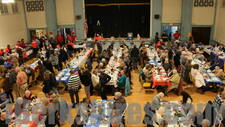State Fire Services Regulations Prompt Public MeetingBy Susan Bush
12:00AM / Tuesday, March 14, 2006
North Adams - New, potentially life-saving changes in the state's carbon monoxide detector laws are the focus of a scheduled March 20 meeting to be held at the Holiday Inn on American Legion Drive and hosted by four Northern Berkshire fire and health departments.
North Adams Fire Director Stephen Meranti said that the meeting is set to begin at 9 a.m.. Real estate agents, multi-family dwelling property owners, property managers, private home owners, and anyone with an interest in the law changes are encouraged to attend the free meeting. In addition to city fire and health department officials, officials of the Clarksburg, Williamstown, and Adams volunteer fire departments and municipal health departments are expected to attend the information session.
New regulations were announced by state Fire Marshal Stephen D. Coan and Board of Fire Prevention Regulations Chairman David Demers last month.
The regulations are included as part of "Nicole's Law," which was signed into law by Gov. Mitt Romney on Nov. 4. The law is named after 7-year-old Nicole Garofalo, who died on Jan. 28, 2005 after lethal amounts of undetected carbon monoxide infiltrated the girl's Plymouth, Mass. home on Jan. 24. The deadly gas filled the home because furnace vents were blocked by snow.
The new regulations impact living units equipped with fossil-fuel burning equipment and /or enclosed parking spaces. The statute mandates that carbon monoxide detectors be placed in those buildings on every level. Additionally, carbon monoxide detectors must be placed within 10 feet of each bedroom or area used for sleeping and in habitable sections of basements and attics. Battery-powered, plug-in with battery back-up, hard-wired with battery back-up, low-voltage, wireless or qualified smoke/carbon monoxide combination systems, according to information made available by the state Department of Fire Services.
Combination smoke/carbon monoxide systems that have been deemed acceptable must be equipped with simulated voice and tone alarms that make a precise distinction between a "smoke" or a "CO" activation.
Most affected residences must be in compliance with the state law by March 31. In situations where a hard-wired system is required under the law's provisions, the deadline for compliance is Jan. 1, 2007.
There are specific situations allowed to implement "alternative compliance options." Explanations of the situations and the alternatives are expected to be part of the meeting.
Property owners are required to inspect, maintain, and when necessary, replace the appropriate carbon monoxide detectors on a yearly basis and at the beginning of every new tenancy. Tenants are advised to report any problems or malfunctions involving detectors to property owners or managers immediately, and in cases of a dual or combination alarm system, learn the differences between a smoke and a carbon monoxide warning.
Municipal health departments are responsible for rental unit carbon monoxide regulation enforcement. Beginning March 31, fire department officials will be required to inspect all residences for carbon monoxide detectors when the homes are sold. Fire department officials already conduct smoke detector inspections of homes that are sold. An inspection fee schedule states that the maximum fee for separate or joint inspections of carbon monoxide detectors and smoke detectors is $50 for single-family dwellings, $100 for two-family buildings, $150 for 3-6 unit structures, and $500 for buildings holding six or more living units, according to information provided by the Department of Fire Services.
Carbon monoxide gas is created when incomplete combustion of fossil fuels such as propane gas, oil, wood, coal, and gasoline occurs. There are circumstances that can cause the incomplete combustion of the fuels, including poor furnace maintenance.
Carbon monoxide is colorless and odorless. The U.S. Consumer Product Safety Commission has set an acceptable carbon monoxide level for human exposure at 15 parts per millions average over 8 hours or 22 parts per millions average for an hour. Exposures to levels of 1,000 parts per millions or higher for more than 30 minutes generates high risk of causing coma or permanent brain damage. Death may occur.
Symptoms of carbon monoxide poisoning include:
*Headache
*Nausea
*Dizziness
*Confusion
*Fainting
*Unconsciousness
Those who believe they may be experiencing carbon monoxide poisoning should:
*Leave the house or building immediately and get into fresh air.
*Contact the fire department from a neighbor's home or other location.
*Seek medical assistance immediately.
Prevention measures include:
*Yearly appliance inspections conducted by qualified technicians before the heating season begins
*Inspections of vent pipes, flues, and chimneys for blockages or leaks.
*NEVER use a charcoal grill indoors.
*Do not rely on a gas oven as a heat source.
*Do not leave running vehicles inside garages, even if the garage door is opened.
*Do not sleep in a room with an unvented gas heater.
*Do not use gasoline-powered tools, such as generators, chain saws, snow-blowers, weed trimmers, or similar equipment, within enclosed spaces.
Additional information about carbon monoxide safety and the new regulations is available at a www.mass.gov/dfs web site.
Susan Bush may be reached via e-mail at suebush@iberkshires.com or at 802-823-9367.
|


















